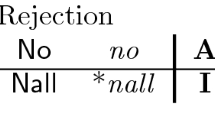Abstract
Natural language contains simple lexical items for some but not all Boolean operators. English, for example, contains conjunction and, disjunction or, negated disjunction nor, but no word to express negated conjunction *nand nor any other Boolean connective. Natural language grammar can be described by a logic that expresses what the lexicon can express by its primitives, and the rest compositionally. Such logic for propositional connectives is described here as a bilateral extension of update semantics. The basic intuition is that a context can be updated by assertion or by rejection, and by one or multiple propositions at once. These distinctions suffice to characterize the logic of the lexicon.
This work has received funding from the European Research Council (ERC) under the European Union’s Horizon 2020 research and innovation program (Grant Agreement No. 758540) within the project EXPRESS: From the Expression of Disagreement to New Foundations for Expressivist Semantics.
Access this chapter
Tax calculation will be finalised at checkout
Purchases are for personal use only
Similar content being viewed by others
Notes
- 1.
- 2.
In fact, the story holds for any many-place connectives with more than one argument. The focus on two-place connectives is for ease of discussion.
- 3.
In fact, these definitions are slightly simpler, since the language under consideration does not contain “genuinely dynamic” operators, such as modals or conditionals, which are sometimes argued to deserve special treatment [9, 25]. The relations of support and validity (and therefore equivalence too) are relative to an update system, but I will not use subscripts for simplicity. The context will make clear which system is under consideration.
- 4.
The definition of ‘Encoding’ requires that the arguments of a connective be atomic. This is necessary, for failures of a formula to encode its classical interpretation (as it is the case with negated conjunction) obviously percolates upwards.
- 5.
- 6.
This also implies that U is not “genuinely” dynamic [16]. This should come as no surprise, given that L does not make provision for anaphora, modals, conditionals, or other expressions with dynamic potential. It would be possible to extended U to a theory of presupposition projection, but this is left for another occasion.
References
Aloni, M.: Logic and Conversation: The case of Free Choice (2021)
Arieli, O., Avron, A.: Reasoning with logical bilattices. J. Log. Lang. Inf. 5(1), 25–63 (1996). https://doi.org/10.1007/BF00215626
Barwise, J., Cooper, R.: Generalized quantifiers and natural language. Linguist. Philos. 4(2), 159–219 (1981)
Carcassi, F., Sbardolini, G.: Assertion, Rejection, and the Evolution of Boolean Operators
Dekker, P.: Dynamic Semantics, Studies in Linguistics and Philosophy, vol. 91. Springer, Dordrecht (2012). https://doi.org/10.1007/978-94-007-4869-9
Enguehard, É., Spector, B.: Explaining gaps in the logical lexicon of natural languages: a decision-theoretic perspective on the square of Aristotle. Seman. Pragmat. 14, 5 (2021)
von Fintel, K., Matthewson, L.: Universals in semantics. Linguist. Rev. 25, 139–201 (2008)
Fitting, M.: Kleene’s logic, generalized. J. Logic Comput. 1, 797–810 (1990)
Gillies, A.S.: Epistemic conditionals and conditional epistemics. Noûs 38, 585–616 (2004)
Ginsberg, M.L.: Multivalued logic: a uniform approach to reasoning in artificial intelligence. Comput. Intell. 4, 265–316 (1991)
Heim, I.: On the projection problem for presuppositions. In: Portner, P., Partee, B.H. (eds.) Formal Semantics - the Essential Readings, pp. 249–260. Blackwell, Oxford (1983)
Horn, L.: A Natural History of Negation. University of Chicago Press, London (1989)
Horn, L.: On the semantic properties of the logical operators in English. Ph.D. thesis, UCLA (1972)
Incurvati, L., Sbardolini, G.: Update Rules and Semantic Universals (ms)
Katzir, R., Singh, R.: Constraints on the lexicalization of logical operators. Linguist. Philos. 36, 1–29 (2013)
Rothschild, D., Yalcin, S.: Three notions of dynamicness in language. Linguist. Philos. 39(4), 333–355 (2016). https://doi.org/10.1007/s10988-016-9188-1
Rumfitt, I.: Yes and no. Mind 109(436), 781–823 (2000). https://doi.org/10.1093/mind/109.436.781
Smiley, T.: Rejection. Analysis 56, 1–9 (1996)
Stalnaker, R.: Assertion. Synt. Seman. 9, 315–332 (1978)
Steinert-Threlkeld, S., Szymanik, J.: Learnability and semantic universals. Seman. Pragmat. 12, 1–35 (2019)
Steinert-Threlkeld, S., Szymanik, J.: Ease of learning explains semantic universals. Cognition 195, 1–10 (2020)
Uegaki, W.: “NAND and the communicative efficiency model. x x, x (ms)
Veltman, F.: Defaults in update semantics. J. Philos. Logic 25(3), 221–261 (1996). https://doi.org/10.1007/BF00248150
Willer, M.: Dynamics of epistemic modality. Philos. Rev. 122, 45–92 (2013)
Yalcin, S.: Epistemic modals. Mind 116, 983–1026 (2007)
Author information
Authors and Affiliations
Corresponding author
Editor information
Editors and Affiliations
Rights and permissions
Copyright information
© 2021 Springer Nature Switzerland AG
About this paper
Cite this paper
Sbardolini, G. (2021). Assertion, Rejection, and Semantic Universals. In: Ghosh, S., Icard, T. (eds) Logic, Rationality, and Interaction. LORI 2021. Lecture Notes in Computer Science(), vol 13039. Springer, Cham. https://doi.org/10.1007/978-3-030-88708-7_15
Download citation
DOI: https://doi.org/10.1007/978-3-030-88708-7_15
Published:
Publisher Name: Springer, Cham
Print ISBN: 978-3-030-88707-0
Online ISBN: 978-3-030-88708-7
eBook Packages: Religion and PhilosophyPhilosophy and Religion (R0)





